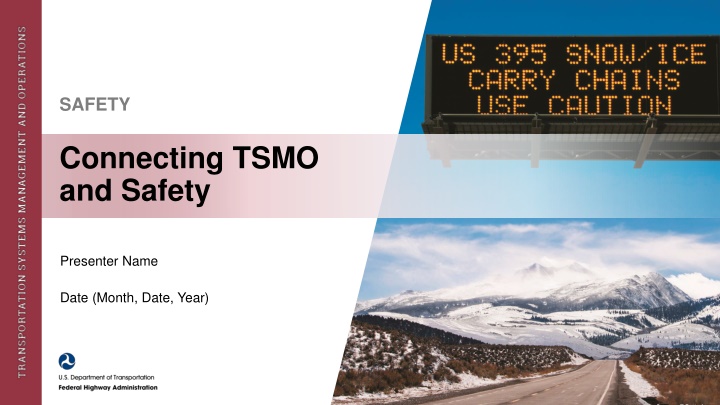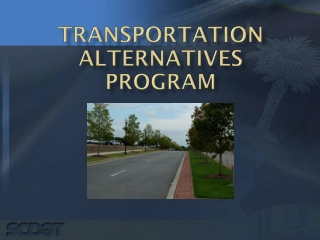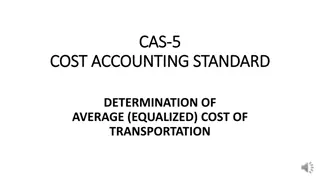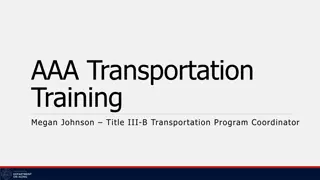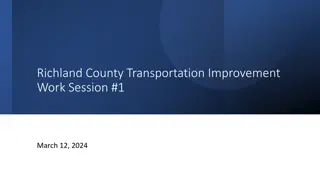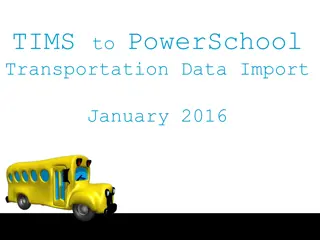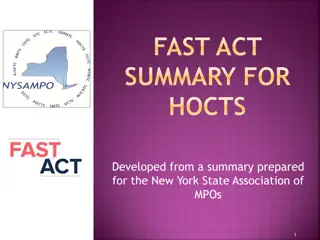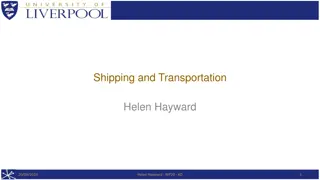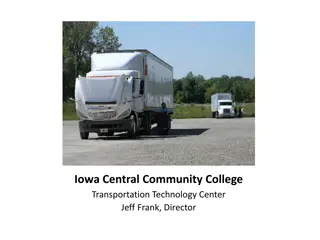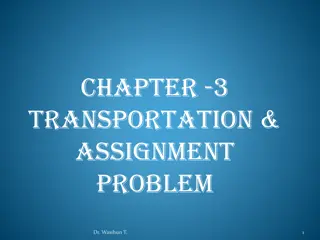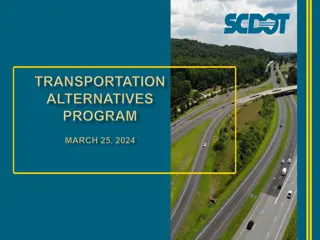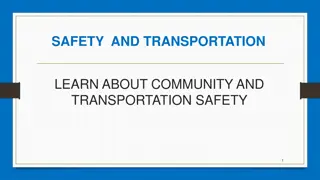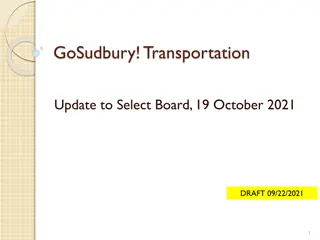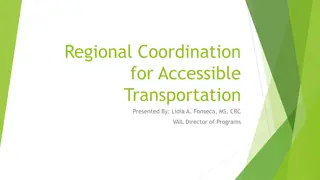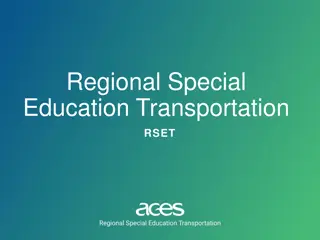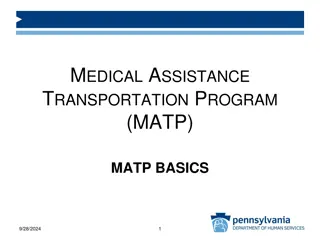Transforming Transportation: TSMO and Safety Integration
Evolving transportation landscape calls for collaboration between TSMO and safety to optimize operational performance, improve safety, and meet evolving customer needs amidst technological advancements and budget constraints. TSMO strategies support state and local DOT goals, enhancing traffic flow, safety, resource efficiency, and economic vitality.
Download Presentation

Please find below an Image/Link to download the presentation.
The content on the website is provided AS IS for your information and personal use only. It may not be sold, licensed, or shared on other websites without obtaining consent from the author.If you encounter any issues during the download, it is possible that the publisher has removed the file from their server.
You are allowed to download the files provided on this website for personal or commercial use, subject to the condition that they are used lawfully. All files are the property of their respective owners.
The content on the website is provided AS IS for your information and personal use only. It may not be sold, licensed, or shared on other websites without obtaining consent from the author.
E N D
Presentation Transcript
SAFETY Connecting TSMO and Safety Presenter Name Date (Month, Date, Year) Source: @Getty Images
Disclaimer The U.S. Government does not endorse products or manufacturers. Trademarks or manufacturers names appear in this presentation only because they are considered essential to the objective of the presentation. They are included for informational purposes only and are not intended to reflect a preference, approval, or endorsement of any one product or entity. 2
Transportation Landscape Is Changing Advances in technology Emerging modes Better data Evolving customer needs and expectations Limited funds and tighter budgets Increasing need to address deteriorating infrastructure and improve access and safety for all users Source: Getty Images. 4
Collaboration Is Important Working together across the transportation enterprise ensures all road users are provided a safe and reliable transportation system. Transportation systems management and operations (TSMO) uses strategies, technologies, mobility services, and programs to optimize the safety, mobility, and reliability of the existing and planned transportation system. TSMO and safety often share common goals and seek to improve safety and mobility for the traveling public. These goals can be achieved with the help of TSMO strategies. Working together will optimize the safety and operational performance of the transportation facilities. 5
Transportation Systems Management and Operations (TSMO) Integrated set of strategies to optimize operational performance of the existing transportation system: Approaches performance from a systems perspective that spans corridors, facilities, jurisdictions, modes, and agencies. Helps agencies balance supply and demand on the system and provide flexible solutions to manage dynamic conditions Compliments capacity projects, or in some cases can provide lower cost, faster alternatives 6
TSMO Supports Many State and Local Department of Transportation (DOT) Goals Reduced congestion Smoother and more reliable traffic flow Improved safety Cleaner air and less wasted fuel More efficient use of resources and existing facilities Increased economic vitality Improved quality of life 7
TSMO Can Support Safety Goals and Activities Work zone safety Intersection safety Primary and secondary crash prevention Traveler information and outreach Speed management Multimodal safety Safety in adverse weather Data-driven decisions Save Lives! 8
TSMO and Safety Connection There is a synergy between TSMO and safety. Eric Hill, MetroPlan Orlando I think there is a great opportunity for us to look at how we can implement operational improvements to save lives and reduce crashes and similarly look at how our safety solutions can be part of an operational strategy as well. Tony Kratofil, formerly of Michigan Department of Transportation 9
Next Steps Bring TSMO and safety leaders together to identify areas of common interest and mutual objectives Find out how TSMO strategies are already supporting safety goals Discuss where TSMO can make an even greater impact on safety goals Identify how safety can support TSMO goals Begin joint efforts to improve the TSMO and safety connection Learn more with the FHWA TSMO and Safety Factsheet at: https://ops.fhwa.dot.gov/publications/fhwahop18091/fhwahop18091.pdf 10
Thank you! For more information, please contact: [INSERT CONTACT INFORMATION] 11
Goals of the Presentation Increase awareness and understanding of transportation systems management and operations (TSMO) Explore how TSMO and safety can support each other Provide examples of coordination between TSMO and safety Discuss opportunities to enhance collaboration between TSMO and safety 13
Presentation Overview What is TSMO? Connecting TSMO and Safety Overview Examples of Collaboration Between TSMO and Safety Overcoming Challenges Next Steps for Connecting TSMO and Safety 14
Definition of TSMO Integrated [set of] strategies to optimize the performance of existing infrastructure through implementation multimodal and intermodal, cross-jurisdictional systems, services, and projects designed to preserve capacity and improve security, safety, and reliability of the transportation system.* * Title 23 of the U.S. Code 101 (a)(30)(A) and FHWA website: https://ops.fhwa.dot.gov/tsmo/ 16
Characteristics of Transportation Systems Management and Operations (TSMO) Offers an integrated set of strategies to optimize operational performance of the existing transportation system Approaches performance from a systems perspective: Spans corridors, facilities, jurisdictions, modes, and agencies Helps agencies balance supply and demand on the system and provide flexible solutions to manage dynamic conditions Complements capacity projects, or in some cases can provide lower cost, faster alternatives 17
Examples of TSMO Strategies Source: Federal Highway Administration. 18
Incident/Event Management Strategies Source: Federal Highway Administration. 19
Traffic Management Strategies Source: Federal Highway Administration. 20
Demand Management Strategies Source: Federal Highway Administration. 21
TSMO Is a Way of Thinking That Supports State Departments of Transportation (DOTs) Missions We provide safe, reliable, and cost-effective transportation options to improve communities and economic vitality for people and businesses. Washington State DOT mission, Our Strategic Plan, https://wsdot.wa.gov/about/secretary-transportation/our-strategic-plan To provide the best multimodal transportation system for Colorado that most effectively and safely moves people, goods, and information. Colorado DOT mission, About CDOT, https://www.codot.gov/about/mission-vision 22
TSMO Supports Many DOT Goals Reduced congestion Smoother and more reliable traffic flow Improved safety Cleaner air and less wasted fuel More efficient use of resources and existing facilities Increased economic vitality Improved quality of life 23
Example TSMO Strategies That Support DOT Goals TSMO Strategies Goals Alternate routes, smart work zones, real-time traffic control, work zone traffic incident management (TIM) Improved traveler and worker safety Traffic signal coordination, congestion pricing, demand management Reduced congestion Traveler information, multimodal coordination, peak-period variable lane use Smoother and more reliable traffic flow 24
TSMO State of the Practice Application of TSMO has accelerated in agencies across the country over the past 5 10 years Recognition of TSMO s value has grown, leading to a variety of approaches for advancing TSMO in agencies. For example: Establishing a TSMO division or office Formalizing a TSMO program Integrating TSMO throughout the agency Establishing a TSMO committee Identifying TSMO champions or liaisons Conducting a TSMO capability maturity model (CMM) self-assessment Developing a TSMO program plan 25
Resources on TSMO What is TSMO? (frequently asked questions): https://ops.fhwa.dot.gov/tsmo Organizing and Planning for Operations web page: https://ops.fhwa.dot.gov/plan4ops Communicating TSMO web page: https://ops.fhwa.dot.gov/plan4ops/focus_areas/communicating_tsmo.htm National Operations Center of Excellence (NOCoE) website: https://www.transportationops.org/ Enhancing Transportation: Connecting TSMO and Construction, factsheet: https://ops.fhwa.dot.gov/publications/fhwahop18092 26
Connecting TSMO and Safety Overview 27
Common Safety Program Elements State DOT safety program activities under the four E's of highway safety: Areas of interest: Strategic Highway Safety Plan (SHSP) Highway Safety Improvement Program Vision Zero (or similar initiative) Safe System Approach Roadway and crash data and analysis Safety countermeasures and crash modification factors Road user behavioral safety Engineering Education Enforcement Emergency medical services 28
TSMO Can Support Safety Goals Work zone safety Intersection safety Primary and secondary crash prevention Traveler information and outreach Speed management Multimodal safety Safety in adverse weather Data-driven decisions Save Lives! 29
TSMO Can Support Safety in Work Zones Queue detection and warning Dynamic lane merge systems Variable speed limits TIM Real-time traveler information Automated speed enforcement Alert systems for workers Source: Unknown author licensed under CC BY-NC-ND. 30
Intersection Safety Signal optimization and coordination: Crash rates on intersection approaches decreased by 6.7% after signal coordination. Studies have found a decrease in crashes from adaptive traffic signal control. Signal timing strategies for pedestrians: Leading pedestrian intervals are designated by FHWA as a Proven Safety Countermeasure. Source: FHWA 31
TSMO Can Help Prevent Secondary Crashes through Traffic Incident Management (TIM) Chance of a secondary incident increases by 2.8% each minute the initial incident continues to pose a hazard TIM strategies support safe, quick clearance through: Service patrols, motorist assist, or highway helper programs Traffic management center monitoring and disseminating traveler information Traveler alerts to slowdowns and crashes on dynamic message signs 32
TSMO Can Provide Traveler Safety Information and Outreach Dynamic message signs relay important safety information to travelers: Notification of slowdowns, queues, or a crash ahead Work zone lane closures ahead Road surface conditions Source: Getty Images. 33
TSMO Can Support Speed Management Active traffic management Variable speed limits Dynamic lane control Queue detection and notification Source: Nick Fewings on Unsplash. 34
TSMO Can Support Safety for All Users and All Modes of Travel Emergency vehicle preemption at traffic signals Pedestrian hybrid beacon Designated lanes or signal phases for transit or bicycles Managed lanes Source: Federal Highway Administration. Source: Flickr Oregon Department of Transportation. 35
TSMO Can Support Safety During Adverse Weather Road weather management supports safety by: Providing timely, accurate, and relevant information about road weather conditions Applying effective treatments on roadways during weather events to ensure safety Initiating adaptive signal timing during weather events Actuating variable speed limits during adverse weather 36
TSMO Can Support Safety With Data-Driven Decisions (1/2) Availability of data has expanded, and many sources can be used to inform both safety and TSMO decisions. Examples below: Crash data Annual average daily traffic Assets Demographics Intersection traffic counts Speed Traffic volume Weather data Traffic incidents Cameras Emergency management Private data companies Ramp monitoring Truck parking systems Wrong-way driver systems Variable speed limits Signal controllers Connected and automated vehicles 37
TSMO Can Support Safety With Data-Driven Decisions (2/2) Data collected as a result of enacting TSMO strategies can help staff assess real-time conditions and safety. Imagery from traffic cameras and video feeds may help identify crash patterns and support near-miss analyses. Speed data can help assess potential speeding-related crash issues. Incident data can be correlated with crash data to understand secondary crash locations. Vehicle mix data can be used to inform freight safety strategies or intersection designs. Combinations of data can be used for strategic decisions and project prioritization. Data can provide additional insights into safety performance. 38
Areas for Collaboration Between TSMO and Safety TSMO and safety often go hand in hand and are cross-cutting areas. Activities where TSMO and safety teams can work together include: Analyzing transportation-related issues and developing solutions Sharing operations data to identify crash risks Participating on review teams for projects in planning and design stages Preparing transportation management plans for work zones Any other areas? Developing an effective TIM program Implementing a speed management program Ensuring an effective signal timing and coordination program Disseminating traveler information Funding projects 39
Integrating TSMO in Safety Formally include TSMO strategies in the Strategic Highway Safety Plan (SHSP). Include TSMO staff in workshops, meetings, or task forces to share benefits and opportunities of TSMO. Offer TSMO training or webinars to safety staff. Look for opportunities to use TSMO strategies to help identify and address safety issues. Conduct safety performance research of TSMO strategies. 40
Integrating Safety in TSMO Include safety goals, objectives, and performance measures in operations-focused plans such as TSMO program plans or the congestion management process. Use crash data to identify potential locations for TSMO strategies to improve both safety and operations. Incorporate safety performance measures in evaluating TSMO strategy benefits. Invite safety staff to TSMO committees, task forces, and working groups and add safety-related items to the agenda. 41
Examples of Collaboration Between TSMO and Safety 42
Arizona DOT Working Together The Safety Group is within Arizona DOT TSMO Division. Enables a more comprehensive view of mobility and safety problems Uses data and resources from both disciplines Helps advance projects faster through greater coordination and funding options The Traffic Management unit manages an Incident Response Unit and a weather response program, which jointly improve mobility and safety during incidents and weather events. All TSMO projects are planned and designed with safety considerations as a top priority. 43
Arizona DOT Operations and Safety Data Overlays operations and safety data to paint a more complete picture Helps understand incidents in congested areas Identifies priority segments by overlaying high-congestion locations (bottlenecks) with high-crash locations Source: Eric Weber on Unsplash. 44
Strategies Improving Safety and Operations in Arizona (1/2) Adaptive ramp meters Dust-detection system and variable speed limits Wrong-way driver system Incident Response Unit Wrong-way detection system wins a 2019 National Roadway Safety Award Source: Arizona Department of Transportation. Note: ADOT = Arizona Department of Transportation; AZDPS = Arizona Department of Public Safety 45
Strategies Improving Safety and Operations in Arizona (2/2) Sign redesign and lane restriping to improve interchange operations and safety: Backups eliminated Reduced speed differentials across lanes Approximately 70% reduction in crashes overall Learn more at: https://transportationops.org/case-studies/us-60-and-i-10-interchange- transformation-using-tsmo-signage-and-restripe-capabilities 46
Interstate 10 Corridor Coalition Truck Parking Availability System Real-time truck parking availability information; roadside dynamic message signs, smartphone and in-cab applications, and websites Expected to improve safety, efficiency, and mobility and reduce emissions 2023 completion California 243 Miles 6 Sites Arizona 392 Miles 8 Sites New Mexico 164 Miles 5 Sites Texas 881 Miles 18 Sites Total 1,680 Miles 37 Sites Source: I-10 Connects. 47
Florida DOTs (FDOTs) Perspective Strategic message of Vital Few priorities: Improving safety Enhancing mobility Inspiring innovation Fostering talent All programs and activities are focused on these elements We see safety and mobility as directly linked. We do not think they are independent of each other. FHWA interview with FDOT 48
Innovative Research and Tools in Florida (1/2) Geographic Information System (GIS), such as Florida GIS portal and Central Florida GIS, allows for: Locations of assets Overlapping congestion and crash issues ATTAIN program, including PedSafe, Greenway, SmartCommunity, and SunStore: PedSafe ped/bike collision avoidance system using connected vehicle technology Greenway technologies that reduce congestion and increase mobility SmartCommunity technologies that connect people to places and services SunStore data storage initiative Learn more at https://cflsmartroads.com/projects/ATTAIN-CFL.html 49
Innovative Research and Tools in Florida (2/2) Real-time crash risk visualization tool: Identifies potential safety problems Evaluates proactive traffic management strategies TSMO strategic assessment tool: Quantifies mobility and safety benefits of select TSMO strategies Ramp metering systems, dynamic message signs, Road Rangers, express lanes, transit signal priority, and adaptive signal control technology Vehicle-to-everything data platform: Will use connected and automated vehicle data to make real-time predictive decisions 50
